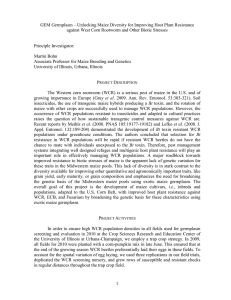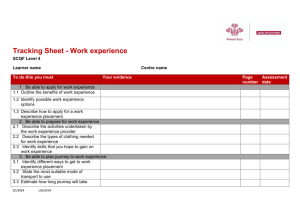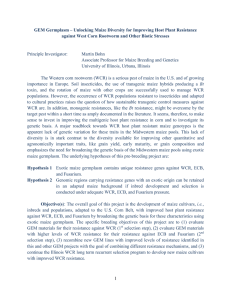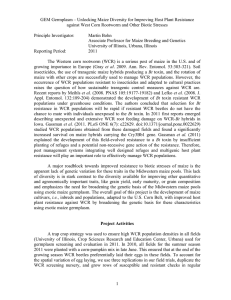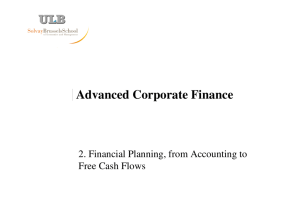Evaluation of GEM Germplasm for Multiple Insect Resistance and Fumonisin Concentration
advertisement
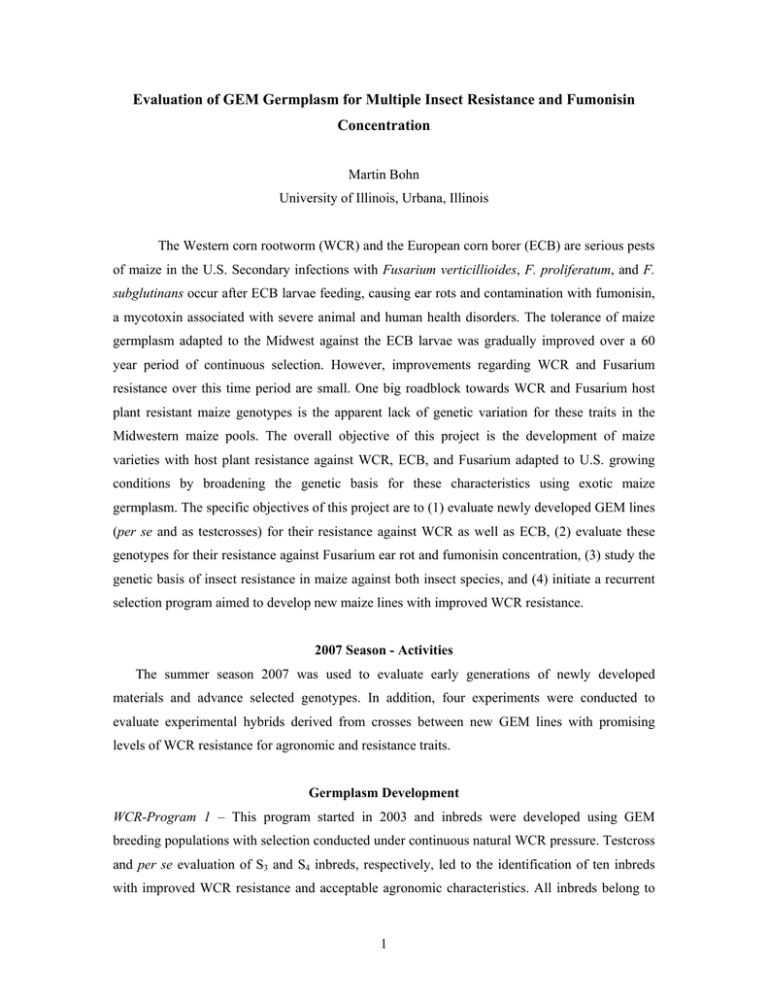
Evaluation of GEM Germplasm for Multiple Insect Resistance and Fumonisin Concentration Martin Bohn University of Illinois, Urbana, Illinois The Western corn rootworm (WCR) and the European corn borer (ECB) are serious pests of maize in the U.S. Secondary infections with Fusarium verticillioides, F. proliferatum, and F. subglutinans occur after ECB larvae feeding, causing ear rots and contamination with fumonisin, a mycotoxin associated with severe animal and human health disorders. The tolerance of maize germplasm adapted to the Midwest against the ECB larvae was gradually improved over a 60 year period of continuous selection. However, improvements regarding WCR and Fusarium resistance over this time period are small. One big roadblock towards WCR and Fusarium host plant resistant maize genotypes is the apparent lack of genetic variation for these traits in the Midwestern maize pools. The overall objective of this project is the development of maize varieties with host plant resistance against WCR, ECB, and Fusarium adapted to U.S. growing conditions by broadening the genetic basis for these characteristics using exotic maize germplasm. The specific objectives of this project are to (1) evaluate newly developed GEM lines (per se and as testcrosses) for their resistance against WCR as well as ECB, (2) evaluate these genotypes for their resistance against Fusarium ear rot and fumonisin concentration, (3) study the genetic basis of insect resistance in maize against both insect species, and (4) initiate a recurrent selection program aimed to develop new maize lines with improved WCR resistance. 2007 Season - Activities The summer season 2007 was used to evaluate early generations of newly developed materials and advance selected genotypes. In addition, four experiments were conducted to evaluate experimental hybrids derived from crosses between new GEM lines with promising levels of WCR resistance for agronomic and resistance traits. Germplasm Development WCR-Program 1 – This program started in 2003 and inbreds were developed using GEM breeding populations with selection conducted under continuous natural WCR pressure. Testcross and per se evaluation of S3 and S4 inbreds, respectively, led to the identification of ten inbreds with improved WCR resistance and acceptable agronomic characteristics. All inbreds belong to 1 the non-Stiff Stalk heterotic pool. The selected inbreds were advanced to the S6 stage in the 2006 summer nursery and the S6 inbreds were testcrossed in the winter nursery 2006/2007. The testcrosses were evaluated in the summer of 2007 (see “Germplasm Evaluation”). In addition, 100 S5 lines derived from GEM breeding population DKXL212:N11a01 were re-evaluated for WCR resistance in the WCR nursery in 2007. The 100 inbreds were grown in two sets under heavy natural WCR pressure and their row appearance was rated before and after flowering taking into account row homogeneity, health status, and the number of root lodged plants (rating score of 0 = homogenous row with healthy plants that show no sign of drought stress, no root lodging; rating score of 5 = heterogenous row, most plants are lodged and show severe drought stress/leaf rolling). Differences between inbreds were highly significant (P<0.01). All inbreds with row ratings of less than two were selected. WCR-Program 2 – Based on their per se performance under intensive WCR infestation and agronomic characteristics (earliness, lodging) 350 S4 lines derived from GEM populations AR16026:N1210, FS8A(S):S0907, UR13085:N0204, and CUBA117:S1520, as well as CIMMYT population MIRT_C5Y were selected in 2006. All 350 S4 lines were grown in two sets in the WCR nursery under heavy natural WCR infestation. Selection was performed between breeding populations and among families within breeding populations. Plants within selected rows were selfed. In total 50 inbreds were selected. A random subset of 90 S3 lines was testcrossed and was evaluated for WCR resistance and yield performance in the summer season of 2007 (see “Germplasm Evaluation”). The testcrosses were performed by AgReliant and Pioneer Hibred. WCR-Program 3 – Cycle 0 of the Illinois WCR Synthetic was planted under natural WCR conditions in the summer season 2006. Individual plants were selected based on phenotypic appearance. A total of 144 plants were selfed. All 144 S1 progenies were evaluated for their WCR resistance in the summer season of 2007. Based on their per se performance, we selected 30 S1 families. Remand seed of the parental individuals will be used to recombine the selected genotypes in 2008 to form cycle C1 of the WCR synthetic. In addition, a set of ten new GEM inbreds and 15 new F2 populations derived from crosses between inbreds improved for WCR resistance were evaluated in the 2007 WCR nursery. 2 Germplasm Evaluation Plant Materials Experiment 1 – The objective of this experiment was to evaluate crosses between newly identified sources of resistance to WCR larvae feeding and to identify the most promising hybrids for base population development with regard to agronomic performance as well as resistance to WCR, ECB, and Fusarium (see Project Report 2006). A set of eight newly developed inbreds derived from population DKXL212:N11a01 with improved levels of WCR resistance and good general combining ability was crossed with three sources of WCR resistance derived from GEM breeding population AR17056:N2025 identified in earlier germplasm screens. All hybrids were evaluated for WCR, ECB, and Fusarium resistance in 2006 and the experiment was repeated in 2007. Experiment 2 – This is a series of experiments with the objective to evaluate a set large set of S3 and S5 lines for their testcross performance. The S3 inbreds were divided into two groups (Group 1: AR16026:N1210 and UR13085:N0204 derived lines; Group 2: mostly CUBA117:S1520 and FS8A-S:S0907, MIRT-C5Y derived lines). Group 1 was testcrossed to tester LH287 (Experiment 2.1) and the other group was testcrossed to testers provided by Pioneer Hibred (Experiment 2.2). Each S5 lines were crossed to three Pioneer testers (Experiment 2.3). Experimental procedures and statistical analysis For all experiments a generalized lattice design was used with two (insecticide protected trials) and three replications (WCR trials in trap crop) and two-row plots. The trials were overplanted and thinned to 25 plants per row, corresponding to 65,000 plants/ha. The experiments and nurseries were planted between April 22 and 25, 2007. The WCR treatment was planted in a WCR trap crop area to ensure a high level of infestation. Resistance to WCR larvae feeding was evaluated using root damage ratings and the percentage of root lodged plants per plot. All root characteristics were determined for five random plants per plot between July 20 and August 3, 2007. The artificial infestation with first generation ECB larvae was performed on June 26 and 28, 2007. Leaf damage caused by ECB larvae feeding was evaluated on July 12, 2007. Artificial infestation with second generation larvae was performed on August 1 and 3, 2007. All experiments were also repeated as yield trials under insecticide protection. The following resistance traits were determined: (1) leaf damage ratings (LDR) using a 1-9 rating scale, as defined by Guthrie and Barry (1989), (2) stalk damage ratings (SDR) using a 1-9 rating scale, as described by Hudon and Chiang (1991), (3) root damage ratings (RDR) using the 3 Iowa State 0-3 damage rating scale, (4) number of root lodged plants (RLD) as the percentage of the total plants per plot, and (5) the percentage of ear tissue damaged by Fusarium ear rot. Fumonisin will be quantified using the CD-ELISA method. We evaluated the following agronomic characteristics in all ECB infested and insecticide protected trials: (1) plant and ear height in cm, (2) female and male flowering in days, as well as (3) stalk and root lodging in percent. All hybrid evaluations were machine harvested and grain yield in bushels per acre and grain moisture in percent were measured. The Fusarium and Fumonisin evaluations are currently in progress. Analyses of variance were performed on plot means for each experiment. Data were screened for outliers according to the test criterion by Anscombe and Tukey (1963). Data values considered as outliers were treated as missing values in subsequent analyses. For a more detailed description of the used statistical procedures see the 2006 project report. For all experiments a base index was calculated including the standardized trait means for yield, days to female flowering, and root damage ratings. For Experiment 1 the index also included stalk damage ratings. Results Experiment 1 - For all agronomic and resistance traits significant (P>0.05) differences between hybrids were found (Table 1). Root damage ratings for the experimental hybrids varied between 0.38 and 2.35 with a mean damage rating of 1.27. Using a base index we were able to identify five hybrids that combine good agronomic performance with high to moderate levels of resistance against WCR (mean RDR for this group = 0.56) and ECB (mean SDR1 for this group = 3.26). Due to their increased levels of resistance this group of experimental hybrids showed higher base index values than the used commercial check varieties. This experiment was also conducted in 2006. A combined analysis across years will increase the accuracy of the results and will help to identify useful breeding populations applying multivariate approaches a described in the 2006 project report. Experiment 2 – In all experiments we detected significant (P<0.05) differences between experimental hybrids for agronomic and resistance traits. In Experiment 2.1 the RDR means among S3 testcrosses varied between 0.94 and 2.53 with an overall mean of 1.80 (Table 2). In Experiment 2.2 the RDR means among S3 testcrosses varied between 1.02 and 2.94 with an overall mean of 1.89 (Table 3). The advanced S5 materials varied for their RDR testcross means between 0.53 and 2.94 with an overall mean of 1.66 (Table 4). We are now in the process of 4 conducting an in-depth analysis of this experiment with the aim of estimating GCA and SCA effects. Future Work All WCR breeding programs will be continued in 2008 and selection decision will be made on testcross performance of lines at the S4 and S6 inbreeding level. In order to increase the efficiency of improving WCR resistance in adapted maize germplasm using GEM material the use of molecular markers linked to resistance QTL is of key importance. In order to facilitate the identification of WCR resistance QTL AgReliant, the USDA-ARS in Columbia, Missouri (Dr. B. Hibbard), and the University of Illinois will conduct a large QTL experiment in 2008. The QTL populations were partly developed using WCR resistance sources derived from GEM breeding crosses. References Anscombe, F.J., and J.W. Tukey. 1963. The examination and analysis of residuals. Technometrics 5:141-160. Guthrie, W.D., and B.D. Barry. 1989. Methodologies used for screening and determining resistance in maize to the European corn borer. pp. 122-129. In CIMMYT. Toward insect resistant maize for the third world. Proc. Int. Symp. Methodologies for developing host plant resistance to maize insects. El Batan, CIMMYT, Mexico. CIMMYT, Int., CIMMYT, Mexico. Hudon, M., and M.S. Chiang. 1991. Evaluation of resistance of maize germplasm to univoltine European corn borer Ostrinia nubilalis (Hübner) and relationship with maize maturity in Quebec. Maydica 36:69-74. 5 Table 1 Means for 32 maize hybrids developed from crosses between S5 lines derived from GEM breeding crosses evaluated for agronomic characteristics, resistance against the western corn rootworm and the European corn borer in field experiments conducted in Urbana, IL, in 2007. 1 Trait 1 Inde x 2 Genotypes 2 AR17056_4 2-1-B AR17056_3 2-2-1-B-B AR17056_4 2-2-1-B-B AR17056_4 5-1-B AR17056_3 3-1-B-B YLD bu/acr e x DKXL212.N11a01-05-11.10 238.90 1.09 241.98 0.97 244.92 0.77 224.51 0.76 219.81 0.67 248.46 0.52 244.18 0.34 210.01 0.33 213.69 0.29 182.19 0.18 2 0 1. 2 0 0.16 213.31 0.08 0.09 0. 0 9 0.09 - 191.51 x DK X L 2 1 2 . N 1 1 a 0 1 - 0 5 - 1 x D K X L 2 1 2 . N 11 a 0 1 - 0 5 - 1 x D K X L 2 1 2 . N 1 1 a 0 1 - 0 9 - 3x DKXL212.N11a01-06-1- 3 1 N 27 AR17056_3 x DKXL212.N11a01-05-12-1-B AR17056_4 x DKXL212.N11a01-09-34-3-1-B D K X L 2 1 2 . N 1 1 a 0 1 - 0 6 - 1 - 3 - 1 -B - B x AR17056_4 AR17056_16 x DKXL212.N11a01-025 - 2 -6 - 1 - B AR17056_16 x DKXL212.N11a01-093-5-1-B A R 1 7 0 5 6 _4 x D K X L 2 1 2 . N 1 1 a 0 1 - 0 2 - 5 2-11-1-B A R 1 7 0 5 6 _ 1 6 x D K X L 2 12 . N 1 1 a 0 1 - 0 5 1-2-1-B AR17056_4 x DKXL212.N11a01-09-34-2-1-B AR17056_16 x UR10001:N1708b-061-2-1-1-B A R 17 0 5 6 _ 3 x D K X L 2 1 2 . N 1 1 a 0 1 - 0 2 - 5 2-11-1-B DKC60-15 215.06 176.97 223.59 2 53 . 8 7 PHT EHT -------- cm -----2 37 . 5 1 1 2 . 5 0 0 260.0 122.5 0 0 235.0 107.5 0 0 240.0 107.5 0 0 232.5 100.0 0 0 230.0 0 80.00 25 2 . 5 1 1 5 . 0 0 0 235.0 0 87.50 220.0 0 82.50 214.0 6 77.98 222.5 0 82.50 205.0 0 8 5. 0 0 220.0 0 95.00 217.5 0 87.50 170.0 0 62.50 22 7 . 5 1 0 2 . 5 0 0 217.5 67.50 6 DMF DFF ------ d ----76.0 78.5 0 0 77.0 80.0 7 0 7 7 . 0 7 9. 0 0 0 77.0 79.0 0 0 77.0 78.5 0 0 79.5 79.5 0 0 77.0 79.5 7 0 77.0 77.0 0 0 77.0 78.5 0 0 76.0 79.8 7 7 76.5 80.0 0 0 79.0 79.5 0 0 76.5 78.5 0 0 77.0 78.0 0 0 76.0 77.0 0 0 79.5 80.0 0 0 77.5 77.5 RDR RLD 0-3 % 19.3 7 14.3 1 10.5 5 24.6 7 16.9 4 20.6 2 31.4 4 19.7 9 25.9 0 22.8 2 41.8 3 17.2 7 26.3 1 42.3 7 27.3 1 36.5 3 55.5 0.62 0.38 0.70 0.59 0.49 0.56 1.51 1.06 1. 1 7 0.79 1.30 0.85 1.27 1.99 1.40 1.42 2.80 SDR1 SDR2 ------ 1-9 -----3.60 5.60 3.20 4.98 4.40 3.86 2. 6 0 4.13 2.50 3.96 3.50 4 . 12 4.10 4.29 4.60 4.84 2.90 4.29 5 . 60 6.62 2.30 5.81 4.20 4.85 3.30 4.68 4. 5 0 4.25 5.50 4.15 4.20 7.00 4.42 7.49 1 Trait 1 2 Genotypes 2 AR17056_16 x DKXL212.N11a01-051-2-2-1-B-B AR17056_3 x DKXL212.N11a01-09-35-1-B AR17056_16 x DKXL212.N11a01-104-2-2-1-B A R 1 7 0 5 6 _ 3 x D K X L 2 1 2 . N 11 a 0 1 - 0 9 - 3 4-4-1-B AR17056_16 x DKXL212.N11a01-093 -4 - 3 - 1 - B AR17056_4 x DKXL212.N11a01-02-52-6-1-B A R 17 0 5 6 _ 1 6 x D K X L 2 1 2 . N 1 1 a 0 1 - 0 9 3-4-2-1-B A R 1 7 0 5 6 _ 3 x DK X L 2 1 2 . N 1 1 a 0 1 - 0 9 - 3 4-3-1-B A R 1 7 0 5 6 _ 1 6 x D K X L 2 1 2 . N 1 1a 0 1 - 1 0 4-2-3-1-B AR17056_16 x DKXL212.N11a01-093 - 4- 4 - 1 - B AR17056_3 x DKXL212.N11a01-02-52-6-1-B) A R 17 0 5 6 _ 4 x D K X L 2 1 2 . N 1 1 a 0 1 - 0 9 - 3 4-4-1-B U R 1 0 0 0 1 : N 1 7 0 8b - 0 4 - 2 - 2 - 4 - 1 - B x AR17056_16 U R 1 0 0 0 1 : N 1 7 0 8 b - 0 4 - 2 - 1- 4 - 2 - B x AR17056_16 A R 1 7 0 5 6 _ 3 x D K X L 2 1 2 . N 1 1 a 0 1 - 0 9- 3 4-2-1-B DKXL212.N11a01-02-5-2-11-1-B x A R 1 7 0 5 6 _ 16 A R 1 7 05 6 _ 1 6 x D K X L 2 1 2 . N 1 1 a 0 1 - 0 6 1-3-1-B-B B 3 7 x H 8 4 S u s c e p t i b l e c h e ck Inde x 0.11 0.14 0.15 0.22 0.24 0.34 0 .3 7 0.40 0.44 0.56 0.63 0 .7 3 0.79 0.95 1.10 1.22 YLD bu/acr e 210.14 186.27 180.24 151.22 188.42 198.44 191.01 183.65 188.64 185.51 176.67 199.57 177.00 184.84 193.12 PHT EHT -------- cm -----0 212.5 0 87.50 24 0 . 0 1 0 0 . 0 0 0 227.5 0 8 5 . 00 252.5 0 97.50 212.5 0 72.50 227.5 0 82.02 2 17 . 5 0 85.00 239.0 6 87.98 215.0 0 72.50 215.0 0 82.50 230.0 110.0 0 0 25 0 . 0 0 97.50 172.5 0 7 0 .0 0 177.5 0 80.00 242.5 0 87.50 DMF DFF ------ d ----0 0 77.0 79.0 0 0 77.0 79.5 7 0 77.0 78.5 0 0 77.0 77.8 7 7 77.0 79.0 0 0 80.0 83.0 0 0 77.0 78.5 0 0 80 . 0 8 0 . 8 7 7 78.0 79.0 0 0 77.0 81.0 0 0 80.0 83.5 0 0 79.5 80.5 0 0 83.0 76.5 0 0 83.5 77.0 0 0 81.0 82.0 0 0 RDR RLD 0-3 % 1.98 1.40 1.42 0.74 1.83 1.19 2.01 0.94 1. 9 4 2.32 1.35 2.16 0.83 1.15 2.35 -/- -/- -/- -/- -/- -/- 0.58 -/- -/- -/- -/- -/- -/- 0.77 -/- -/- -/- -/- -/- -/- 2.23 7 2 35.6 1 42.0 9 28.5 9 49.9 7 26.4 1 25.5 9 43.3 3 34.8 6 34.0 1 50.3 6 30.4 9 37.7 1 18.7 1 25.1 7 3 9. 9 4 22.1 2 25.0 8 61.9 0 SDR1 SDR2 ------ 1-9 -----3.50 7.29 2.80 2.96 2.50 4.16 5.30 3.81 2.20 2.35 3.80 4.67 3.10 4.16 3.40 3.62 3.30 2.83 3 .3 0 4.65 3.50 4.69 5.00 6.24 3.00 5.53 4.50 6.28 4.50 3.68 3.30 4.08 4.00 4.30 -/- -/- 1 Trait 1 2 Genotypes 2 Inde x YLD bu/acr e PHT EHT -------- cm ------ DMF DFF ------ d ----- RDR RLD 0-3 -/74.5 0 76.0 0 -/- -/74.0 0 76.0 0 -/- 0.15 % 17.4 6 -/- 0.60 83.1 4 78.0 0 0.98 57.4 7 79.2 9 Bt check -/- -/- DK537 -/- 247.82 33D31 Mo17xB73 -/-/- 236.93 -/- -/220.0 0 240.0 0 -/- 8.78 5.53 5.06 80.13 86.86 224.0 2 78.11 Standard Error 3 0.62 3 Repeatability (%) Mean (without Checks) 1 2 3 0.04 201.22 -/75.00 92.50 -/- 90.85 SDR1 SDR2 ------ 1-9 ------/- -/- -/- -/- -/- -/-/- -/-/- 5.60 4 .8 0 6.74 5.61 0.47 17.0 1 8.42 29.1 7 29.6 1 0.54 60.8 5 0.79 40.5 2 3.70 4.56 1.27 Index = 0.66×YLDstd + 0.33×DFFstd + RDRstd + 0.50×SDR1std + 0.50×SDR2std ; YLD = Yield; PHT = Plant height; EHT = Ear height; DMF = Days to male flowering; DFF = Days to female flowering; RDR = Root damage rating; RLD = Root lodging; SDR = Stalk damage rating (1= no damage, 9 = stalk broken below ear) evaluated for plants manual infested at 1st (SDR1) and 2nd brood ECB (SDR2) moths appearance; AR17056_3 = AR17056:N2025-522-1-B-B-B; AR17056_4 = AR17056:N2025-728-1-B-B-B; AR17056_16 = AR17056:N2025 Select # 5-B-B. Standard deviation is given. 8 Table 2 Means for 60 maize hybrids developed from crosses between S3 lines derived from GEM breeding crosses and tester LH287 evaluated for agronomic characteristics and WCR resistance in field experiments conducted in Urbana, IL, in 2007. Traits Genotypes 1 Index YLD bu/acre Bt Check 1 Bt Check 2 AR16026:N1210-26-3-2 AR16026:N1210-19-1-7 UR13085:N0204-6-2-6 U R 1 3 0 8 5 : N 0 2 04 - 4 - 2 - 4 UR13085:N0204-6-2-3 AR16026:N1210-26-3-6 AR16026:N1210-26-2-3 A R 1 6 0 2 6 : N 1 2 1 0 -1 9 - 2 - 2 A R1 6 0 2 6 : N 1 2 1 0 - 2 6 - 3 - 1 UR13085:N0204-4-2-1 UR13085:N0204-6-2-5 U R 1 3 0 8 5 : N 0 2 0 4 - 4 - 2- 5 U R 1 3 08 5 : N 0 2 0 4 - 4 - 1 - 7 AR16026:N1210-19-1-8 AR16026:N1210-19-1-5 AR16026:N1210-19-1-3 A R 1 6 0 2 6 :N 1 2 1 0 - 2 6 - 2 - 1 AR16026:N1210-26-1-1 UR13085:N0204-6-2-4 AR16026:N1210-19-2-1 A R 1 6 0 2 6 : N1 2 1 0 - 1 9 - 1 - 4 UR13085:N0204-4-2-2 UR13085:N0204-4-2-3 UR13085:N0204-4-1-3 A R 1 6 0 2 6 : N 1 2 1 0- 1 9 - 3 - 4 AR16026:N1210-26-3-5 5.36 4.42 2.26 1.46 1 .4 4 1.19 1.13 1.00 0.99 0.98 0.97 0.87 0.86 0.84 0.76 0.58 0.54 0.43 0.40 0.40 0.38 0.38 0.30 0.30 0.29 0 . 28 0.22 0.21 249.88 240.35 232.52 210.18 225.08 230.29 210.24 228.49 23 6 . 1 4 210.10 237.78 215.99 2 2 5. 1 2 208.29 205.78 231.49 209.13 225.56 217.45 215.26 228.35 193.87 196.05 217.47 216.92 217.86 172.20 229.55 PHT EHT -------- cm -----212.45 74.20 216.56 76.64 225.21 88.14 1 9 5 .3 9 6 8 . 1 0 212.33 86.71 198.22 76.76 216.63 89.91 2 2 2 . 0 5 81 . 8 7 213.18 82.13 210.78 74.30 211.22 76.69 2 0 0 . 0 5 7 8 .7 1 211.05 74.90 197.18 81.56 195.22 67.58 213.17 81.74 194.35 62.56 214.24 84.81 206.88 81.22 209.16 76.76 2 19 . 6 9 8 8 . 0 2 205.11 73.47 205.33 81.38 200.08 76.92 2 0 1 . 50 7 4 . 5 2 200.28 68.63 191.19 63.09 203.20 76.64 9 DMF DFF ------ d ----74.20 75.00 76.64 76.63 88.14 75.06 68.10 75.03 86.71 75.60 76.76 76.47 8 9 . 9 1 7 6 .2 7 81.87 76.37 82.13 76.28 74.30 76.30 7 6 . 6 9 7 5 .6 8 78.71 76.27 74.90 76.38 81.56 75.62 67.58 76.90 81 . 7 4 7 6 . 9 4 62.56 77.28 84.81 78.03 81.22 76.32 7 6 .7 6 7 5 . 6 7 88.02 75.10 73.47 76.40 81.38 75.70 76.92 76.32 74.52 76.36 68.63 75.73 63.09 78.63 7 6 . 6 4 7 5. 0 3 RDR RLD 0-3 % 0.42 0.46 1.36 1.38 1.51 1.57 1.36 1.63 1.74 1.41 1.84 1.53 1.64 1.52 1 . 37 1.76 1.45 1.61 1.72 1.77 2.01 1.42 1.56 1.76 1.75 1.84 0.94 2.10 8 . 41 1 0 .5 8 39.13 19.05 33.42 32.21 33.75 24.59 25.38 29.30 27.21 11.80 35.20 38.45 32.14 41.20 7.41 11.48 40.77 29.62 48.23 16.85 1 9. 8 5 33.22 29.41 37.73 17.33 30.30 Traits Genotypes 1 Index YLD bu/acre AR16026:N1210-19-3-5 AR16026:N1210-19-1-1 UR13085:N0204-6-3-1 A R 1 6 0 2 6 : N 1 2 1 0 -1 9 - 1 - 9 AR 1 6 0 2 6 : N 1 2 1 0 - 2 6 - 3 - 3 AR16026:N1210-19-2-4 UR13085:N0204-4-1-6 U R 1 3 0 8 5 : N 0 2 0 4- 6 - 2 - 1 UR 1 3 0 8 5 : N 0 2 0 4 - 6 - 1 - 8 UR13085:N0204-5-1-2 UR13085:N0204-4-1-1 A R 1 6 0 2 6 : N 1 2 1 0 -2 6 - 3 - 7 AR16026:N1210-19-3-1 UR13085:N0204-4-1-2 UR13085:N0204-6-1-9 U R 1 3 0 8 5 : N 0 2 04 - 5 - 1 - 1 AR16026:N1210-19-1-10 AR16026:N1210-26-3-4 AR16026:N1210-19-1-2 U R 1 3 0 8 5 : N0 2 0 4 - 6 - 1 - 2 UR13085:N0204-4-1-4 AR16026:N1210-19-3-2 AR16026:N1210-19-3-6 Non-Bt Check A R 16 0 2 6 : N 1 2 1 0 - 1 9 - 1 - 6 UR13085:N0204-6-2-2 AR16026:N1210-26-1-2 A R 1 6 0 2 6 : N 1 2 1 0 -1 9 - 2 - 3 UR13085:N0204-6-1-3 UR13085:N0204-4-1-5 UR13085:N0204-6-1-7 0.11 0.08 0.07 0.02 -0.08 -0.11 -0.12 -0.15 -0.15 -0.19 -0.28 -0.29 -0.36 -0.39 - 0 . 40 -0.44 -0.46 -0.50 -0.52 -0.52 -0.62 -0.65 -0.70 -0.76 -0.82 -0.95 -0.96 -1.19 -1.52 -1.68 -1.84 222.04 202.70 216.84 215.64 216.30 203.19 198.42 226.90 207.45 214.34 199.09 221.11 229.02 206.03 215.24 213.14 211.72 207.47 203.75 192.67 189.86 203.47 204.16 237.15 226.67 231.40 200.76 192.90 171.63 199.59 187.90 PHT EHT -------- cm -----192.17 75.34 209.41 79.95 216.13 78.11 202.64 73.38 219.79 81.22 1 9 7 . 14 7 5 . 1 8 204.95 72.69 215.63 87.31 214.57 76.97 2 0 6 . 1 9 69 . 9 2 197.66 71.39 218.08 79.73 201.82 75.12 2 0 0 . 16 7 3 . 2 6 211.61 77.94 204.66 86.01 195.89 63.67 2 0 8. 1 8 7 8 . 1 6 222.30 76.66 205.39 77.15 200.30 74.79 19 4 . 1 8 7 2 . 3 2 193.96 66.11 220.80 84.58 199.96 73.31 2 1 7 . 6 3 8 5. 9 0 213.85 75.52 222.08 89.59 214.80 83.10 203.91 80.17 203.80 83.02 10 DMF DFF ------ d ----7 5 . 3 4 76 . 7 2 79.95 77.03 78.11 76.31 73.38 77.67 8 1 . 2 2 7 6. 9 6 75.18 75.75 72.69 75.68 87.31 75.63 7 6 . 9 7 7 6. 3 3 69.92 75.66 71.39 75.60 79.73 76.40 7 5 . 1 2 78 . 6 5 73.26 76.94 77.94 77.64 86.01 76.33 63.67 76.34 78.16 76.35 76.66 77.02 77.15 77.95 7 4 . 79 7 6 . 9 6 72.32 76.98 66.11 77.06 84.58 78.27 7 3 . 3 1 7 6 .3 9 85.90 75.70 75.52 76.34 89.59 76.29 8 3 . 1 0 7 9. 2 9 80.17 76.40 83.02 78.00 RDR RLD 0-3 % 1.84 1.57 1.84 1.68 1.81 1.80 1.75 2.13 1.80 1.98 1.83 2.02 1.88 1.80 1.84 1.98 1.97 1.93 1.81 1.56 1.68 1.86 1.88 2.18 2.29 2.48 2.02 2.01 1.51 2.27 1.99 43.01 23.93 45.73 20.46 48.31 4.44 28.62 39.12 55.56 44.82 19.18 43.62 21.23 18.52 45.52 38.86 25.60 26.69 43.24 36 . 0 7 11.78 24.74 25.77 25.11 56.04 46.48 26.57 32.90 27.88 46.96 38.82 Traits Genotypes 1 Index YLD bu/acre UR13085:N0204-4-1-8 UR13085:N0204-6-1-4 UR13085:N0204-6-1-6 U R 1 3 0 8 5 : N 0 2 0 4- 6 - 1 - 1 B73×Mo17 Standard Error Repeatability (%) Mean (without Checks) 4 5 -1.92 -1.93 - 2 . 44 -2.50 -4.10 2 0.68 2 -/0.00 198.85 177.50 199.76 198.73 125.21 PHT EHT -------- cm -----209.52 75.38 230.73 90.23 215.22 84.76 219.86 85.32 201.13 84.81 DMF DFF ------ d ----7 5 . 3 8 76 . 3 0 90.23 78.68 84.76 77.98 85.32 76.72 84.81 79.97 RDR RLD 0-3 % 2.36 1.81 2.37 2.53 1.81 55.56 40.88 49.73 82.07 25.91 7.48 3.39 3.42 0.64 0.78 0.29 9.69 67.10 68.55 44.61 32.66 42.80 20.48 23.05 209.49 207.51 77.88 76.62 76.91 1.80 32.82 Index = 0.66 YLDstd + 0.33 DFFstd + RDRstd; YLD = Yield; PHT = Plant height; EHT = Ear height; DMF = Days to male flowering; DFF = Days to female flowering; RDR = Root damage rating; RLD = Root lodging. Standard deviation is given. 11 Table 3 Means for 50 maize hybrids developed from crosses between S3 lines derived from GEM breeding crosses and a tester (provided by Pioneer Hibred, Inc.) evaluated for agronomic characteristics and WCR resistance in field experiments conducted in Urbana, IL, in 2007. Genotype 1 Index 1 YLD bu/acre 33F85 A R 16 0 2 6 . N 1 2 1 0 - 2 6 - 1 - 1 UR13085.N0204-6-1-1 34A16 CUBA117.S1520-24-3-1 CUBA117.S1520-22-3-1 34P89 C U B A 1 1 7 . S 1 5 2 0- 2 4 - 2 - 1 AR16026.N1210-26-3-1 UR13085.N0204-4-2-1 CUBA117.S1520-3-3-1 U R 1 3 0 8 5 . N 0 2 0 4 - 5 -1 - 1 31P41 U R 1 3 0 8 5. N 0 2 0 4 - 4 - 3 - 1 33D13 CUBA117.S1520-17-2-1 CUBA117.S1520-31-2-1 33H26 CUBA117.S1520-25-1-1 U R 1 3 0 8 5 . N 0 2 0 4 - 6 -2 - 1 F S 8 A- S . S 0 9 0 7 - 3 7 - 2 - 1 AR16026.N1210-26-2-1 UR13085.N0204-4-1-1 FS8A-S.S0907-1-1-1 U R 1 3 0 8 5 . N0 2 0 4 - 6 - 3 - 1 CUBA117.S1520-79-2-1 CUBA117.S1520-57-1-1 CUBA117.S1520-31-1-1 1.04 0.84 0.78 0.73 0.69 0. 6 8 0 . 57 0.57 0.54 0.47 0.47 0.43 0.40 0.37 0.37 0.36 0.34 0.34 0.30 0.29 0.22 0.21 0.19 0.19 0.18 0.09 0.08 0 . 08 243.83 217.07 241.69 218.49 196.00 220.88 251.35 237.29 230.79 201.00 2 2 1 .1 7 215.19 238.23 222.75 258.85 210.52 216.11 238.65 2 4 5. 7 3 210.80 222.47 233.25 210.09 234.18 204.12 208.28 231.53 196.38 Trait PHT EHT -------- cm ----241.55 94.17 246.66 99.00 282.03 122.12 225.13 80.17 2 5 3. 6 5 1 0 1 . 1 5 256.35 104.25 241.94 95.59 262.49 101.99 257.24 113.81 237.45 9 8. 5 6 258.27 120.81 232.29 105.77 242.84 101.22 244.41 109.66 225.74 89.33 256.66 117.83 233.23 102.38 248.04 9 6 .8 5 262.94 116.09 248.09 111.31 253.45 111.49 234.18 105.35 23 9 . 5 8 1 1 1 . 3 3 248.92 112.21 248.71 110.23 237.31 99.92 2 3 9 . 70 1 0 6 . 3 5 244.60 107.21 12 DMF DFF ------ d ----77.03 76.91 77.00 80.03 77.05 78.10 7 7 .0 0 7 8 . 5 8 77.05 79.22 77.00 80.42 77.03 76.78 77.05 79.51 7 7 . 1 0 7 9. 3 3 77.01 78.59 77.02 80.46 76.94 80.09 78.47 79.97 77.00 80.37 77.97 78.74 7 6 . 9 3 80 . 0 3 76.99 79.54 77.06 78.08 80.02 80.45 76.97 79.26 77.04 79.66 78.07 81.07 76.98 80.82 78.44 80.14 77.02 80.80 76.96 79.63 77.94 79.98 77.98 80.63 RDR RLD 0-3 % 1.39 1. 2 0 1.67 1.36 1.02 1.47 2.10 1.86 1.78 1.39 1.73 1.70 1.64 1.88 2.18 1.71 1.81 2.17 1.39 1.80 2 .0 5 1.92 1.90 1.84 1.80 2.00 2.09 1.49 46.80 41.30 26.54 35.71 34.80 34.11 53.98 67.99 53.91 32.42 36.14 16.23 43.95 46 . 2 9 3 5 . 45 37.17 33.40 40.57 45.94 38.68 42.41 51.98 27.14 25.09 3 0. 1 4 50.89 29.19 46.34 Genotype 1 Index YLD bu/acre CUBA117.S1520-15-2-1 AR16026.N1210-19-2-1 CUBA117.S1520-9-2-1 C U B A 1 1 7 . S 1 5 2 0 - 24 - 2 - 1 CU B A 1 1 7 . S 1 5 2 0 - 3 1 - 3 - 1 AR16026.N1210-19-1-1 FS8A-S.S0907-37-3-1 A R 1 6 0 2 6 . N 1 2 10 - 1 9 - 3 - 1 CUBA117.S1520-44-2-1 CUBA117.S1520-15-1-1 CUBA117.S1520-79-1-1 M I R T - C 5 Y - 5 -3 - 1 C U BA 1 1 7 . S 1 5 2 0 - 3 - 1 - 1 CUBA117.S1520-17-1-1 CUBA117.S1520-22-1-1 C U B A 1 1 7 . S 1 5 2 0 - 2 5- 2 - 1 C U BA 1 1 7 . S 1 5 2 0 - 1 8 - 1 - 1 CUBA117.S1520-44-3-1 CUBA117.S1520-9-3-1 C U B A 1 1 7 . S 1 5 2 0 - 9- 1 - 1 C UB A 1 1 7 . S 1 5 2 0 - 4 4 - 1 - 1 MIRT-C5Y-5-2-1 MIRT-C5Y-3-2-1 MIRT-C5Y-5-1-1 C U B A 1 1 7 . S 1 5 2 0 - 3 - 2 -1 M I R T -C 5 Y - 1 - 1 - 1 MIRT-C5Y-1-3-1 WCR_Bt Susceptible Check Susceptible Check+Ins. 0.07 0.03 0.00 -0.01 -0.03 -0.09 -0.11 -0.12 -0.15 -0.20 - 0 .2 4 -0.28 -0.31 -0.34 -0.35 -0.36 -0.42 -0.50 -0.52 -0.53 -0.78 -0.82 -1.02 -1.06 -1.61 -1.91 -1.91 -/-/-/- 214.81 190.40 2 33 . 7 3 232.58 204.28 210.87 219.75 209.42 184.30 196.00 210.42 209.33 217.37 228.95 2 1 4 .8 0 203.83 198.86 143.01 2 39 . 7 4 224.06 200.42 221.53 174.24 2 0 3 . 77 158.94 147.55 152.78 -/-/-/- Trait PHT EHT -------- cm ----236.14 95.41 2 4 6 . 6 9 1 00 . 3 7 287.99 130.66 261.72 103.70 253.64 108.67 249.60 105.17 253.62 105.48 231.14 97.55 253.47 104.15 2 3 9 . 98 98.38 250.76 112.56 255.35 118.13 244.44 97.07 254.02 9 9 . 75 240.19 106.97 244.94 111.29 257.05 119.60 245.68 9 4. 2 1 263.95 113.32 299.03 126.81 250.23 93.69 261.68 121.07 2 6 0 . 4 0 13 3 . 2 2 264.81 121.36 282.46 132.77 267.68 117.24 267.08 120.71 -/-/-/-/-/-/- 13 DMF DFF ------ d ----7 6 . 9 8 7 9. 2 3 76.97 82.04 80.04 80.89 78.02 80.72 7 6 . 9 8 8 0. 8 4 78.05 80.87 78.99 80.58 79.01 81.61 77.99 81.02 77.02 80.33 78.97 81.15 78.02 81.58 77.94 81.06 79.97 81.76 78.45 81.17 79.01 80.99 8 0 . 4 1 8 1 .7 1 77.01 80.85 79.53 81.44 79.99 81.79 7 7 . 0 1 8 0 . 31 79 . 0 2 8 1 . 5 6 80.01 82.89 80.03 81.51 81.50 82.78 81.02 83.02 8 0 . 0 0 8 2 . 51 -/-/-/-/-/-/- RDR RLD 0-3 % 2.13 1.78 1.56 2.20 2.08 1.92 1.80 1.63 1.57 2.14 1.81 2.14 2. 3 5 1.93 2.19 1.84 1.38 1.63 2.47 2.08 2.94 2.70 1.85 2.39 1.85 2.18 2.60 0.37 1.97 1.84 48.82 20.93 51.48 37.70 63.75 46.36 41.23 43.44 33.21 36.47 32.29 31.54 36.19 32.39 60.73 44.89 42.38 55.98 57.81 32.45 54.80 56.65 43.83 61.60 62.42 6 2 .1 6 47.97 24.38 55.48 57.35 1 Genotype Index YLD bu/acre Standard Error Repeatability (%) M e a n ( w i t h o u t C h ec k s ) 1 2 Index = 0.66 YLDstd DMF = Days to male Root lodging. Standard deviation 2 0.63 -0.03 11.28 67.49 209.65 Trait PHT EHT -------- cm ----6.40 4.65 65.61 73.26 253.10 109.76 DMF DFF ------ d ----0.52 0.53 68.90 77.23 78.15 80.70 RDR 0-3 RLD % 0.37 10.97 5.30 5.07 1.89 42.73 + 0.33 DFFstd + RDRstd; YLD = Yield; PHT = Plant height; EHT = Ear height; flowering; DFF = Days to female flowering; RDR = Root damage rating; RLD = is given. 14 Table 4 Means for 28 maize hybrids developed from crosses between ten S5 lines derived from GEM breeding crosses and three testers (provided by Pioneer Hibred, Inc.) evaluated for agronomic characteristics and WCR resistance in field experiments conducted in Urbana, IL, in 2007. Genotypes Index1 YLD bu/acre 34P89 33F85 33H26 31P41 33F85 33D13 DKXL212.N11a01-02-5-2-6-1-X/PHISS3 DKXL212.N11a01-05-1-2-1-X)1]/PHISS1 DKXL212.N11a01-02-5-2-2-11-1X)1]/PHISS1 DKXL212.N11a01-06-1-3-1 x PHISS2 DKXL212.N11a01-05-1-2-2-1 x PHISS2 DKXL212.N11a01-02-5-3-2 x PHISS2 DKXL212.N11a01-06-1-3-1 x PHISS3 DKXL212.N11a01-05-1-2-2-1 x PHISS1 DKXL212.N11a01-09-3-4-2-1 x PHISS3 DKXL212.N11a01-09-3-5-1 x PHISS3 DKXL212.N11a01-06-1-3-1 x PHISS1 DKXL212.N11a01-09-3-5-1 x PHISS1 DKXL212.N11a01-05-1-2-1 x PHISS2 DKXL212.N11a01-09-3-4-2-1 x PHISS1 DKXL212.N11a01-05-1-2-1 x PHISS3 ZUIDKXL212.N11a01-02-5-2-6-1 x PHISS1 ZUIDKXL212.N11a01-09-3-4-4-1 x PHISS3 ZUIDKXL212.N11a01-09-3-4-3-1 x PHISS3 DKXL212.N11a01-05-1-2-2-1 x PHISS3 DKXL212.N11a01-02-5-2-2-11-1 x PHISS2 ZUIDKXL212.N11a01-02-5-2-6-1 xPHISS2 ZUIDKXL212.N11a01-09-3-4-3-1 x PHISS1 PHT Trait EHT DMF -------- cm ------ DFF RDR RLD ------ d ----- 0-3 % 1.39 1.17 0.94 0.63 0.37 0.36 0.31 0.29 269.36 242.67 243.14 228.86 258.38 206.33 215.75 211.39 228.44 236.56 231.70 228.54 228.78 227.15 255.52 218.89 88.12 97.32 81.88 85.62 93.74 102.01 130.00 89.69 74.97 75.66 77.38 78.08 76.50 75.92 80.01 77.90 75.00 76.00 78.00 79.00 77.00 78.50 81.50 79.50 1.24 0.94 0.79 0.83 2.24 1.59 0.53 1.16 37.38 31.30 50.17 51.90 42.75 41.74 7.21 25.29 0.21 0.11 0.05 0.04 -0.11 -0.19 -0.20 -0.23 -0.35 -0.39 -0.42 -0.45 -0.49 -0.58 -0.59 -0.60 -0.64 -0.76 -0.79 -0.81 212.84 225.48 224.40 233.06 195.06 218.72 185.49 117.42 207.54 196.16 226.51 183.98 201.46 195.93 156.60 165.82 214.37 216.17 232.36 195.96 238.96 236.04 246.04 237.67 235.76 226.39 241.28 228.44 219.65 221.80 246.39 228.78 240.70 237.43 247.33 250.41 231.04 241.39 247.09 210.00 99.07 108.46 120.62 114.85 104.54 102.19 102.68 93.61 90.65 86.39 110.77 91.26 108.30 110.59 98.58 106.42 93.12 105.77 110.77 74.72 78.43 78.47 78.54 79.16 79.01 78.43 78.42 77.07 79.17 78.90 80.93 78.42 79.62 80.54 79.57 78.99 80.67 80.90 81.62 79.53 79.50 80.00 78.50 81.00 80.00 80.50 80.50 77.50 80.00 79.50 82.00 80.00 81.00 81.50 80.50 81.00 81.50 81.00 82.00 80.50 1.14 1.51 1.57 1.53 1.18 1.90 1.37 0.70 1.74 1.70 1.61 1.74 1.72 1.48 1.16 1.51 1.85 2.00 2.10 2.18 37.27 40.24 33.68 35.40 17.27 43.66 19.50 16.10 48.99 54.60 43.02 39.28 20.13 38.38 55.88 47.67 32.13 52.27 30.99 50.86 15 1 Genotypes Index YLD bu/acre ZUIDKXL212.N11a01-09-3-4-4-1 x PHISS1 DKXL212.N11a01-09-3-4-2-1 x PHISS2 ZUIDKXL212.N11a01-09-3-4-3-1 x PHISS2 ZUIDKXL212.N11a01-09-3-4-4-1 x PHISS2 DKXL212.N11a01-02-5-2-2-11-1 x PHISS3 DKXL212.N11a01-02-5-3-2 x PHISS3 WCR-Bt Suscept. Check Suscept. Check+Insecticide Standard Error Repeatability (%) Mean (without Checks) 3 4 Index = 0.66 YLDstd + flowering; DFF = Days Standard deviation is -0.83 -/-/-/-/-/-/-/-/- 166.52 -/-/-/-/-/-/-/-/- 0.632 PHT Trait EHT DMF -------- cm -----219.55 -/-/-/-/-/-/-/-/- 87.50 -/-/-/-/-/-/-/-/- DFF RDR RLD ------ d ----- 0-3 % 79.41 -/-/-/-/-/-/-/-/- 1.77 2.94 2.30 1.64 1.64 2.23 0.30 2.36 1.19 52.27 46.90 48.30 44.06 49.72 32.39 5.66 67.22 30.88 81.00 -/-/-/-/-/-/-/-/- 9.45 5.20 6.43 1.01 1.05 0.55 9.40 83.02 58.50 53.38 50.00 55.55 6.43 29.50 0.05 199.96 235.07 101.76 79.29 80.43 1.66 38.75 0.33 DFFstd + RDRstd; YLD = Yield; PHT = Plant height; EHT = Ear height; DMF = Days to male to female flowering; RDR = Root damage rating; RLD = Root lodging. given. 16

